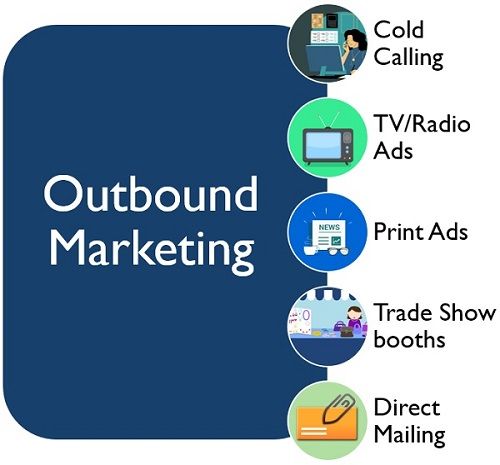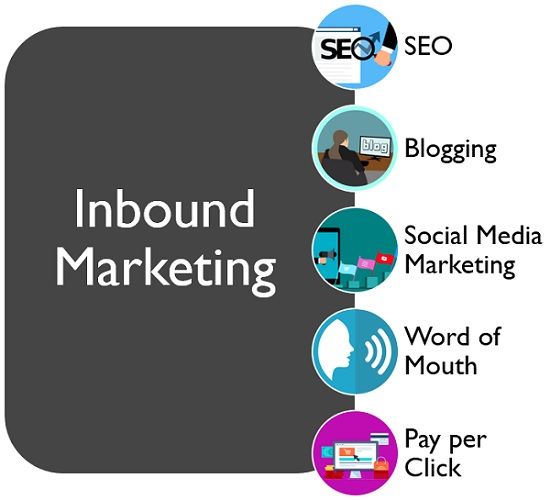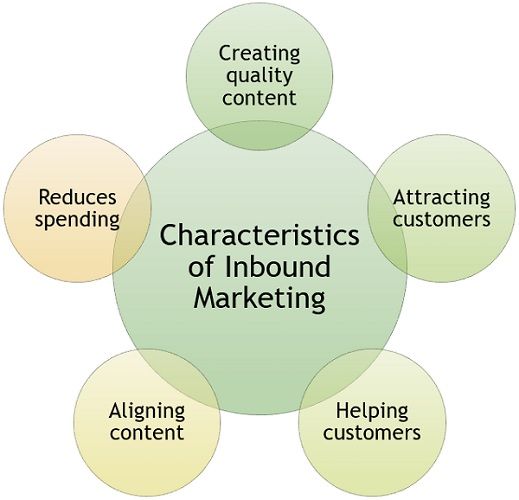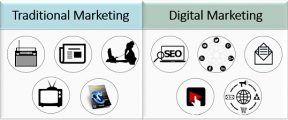 Inbound Marketing is a form of marketing. In this, the customer sees ads when they search for a particular product that the company offers. Paid search advertising is one classic example of inbound marketing.
Inbound Marketing is a form of marketing. In this, the customer sees ads when they search for a particular product that the company offers. Paid search advertising is one classic example of inbound marketing.
Outbound Marketing, is another form of marketing. Here, the marketer finds out customers, starts interaction and conveys information in the form of messages to people irrespective of their interest.
The basic difference between inbound and outbound marketing is that in the case of the former, the marketer does not force the promotional messages onto the customers. Rather, the customer comes on their own to get the relevant information. Therefore, the marketer does not run after the customer’s attention.
To know more such differences between the two, consider reading this post till the end. You will get all the information that you need.
Content: Inbound Vs Outbound Marketing
Comparison Chart
| Basis for Comparison | Inbound Marketing | Outbound Marketing |
|---|---|---|
| Meaning | Inbound Marketing is all about drawing the attention of the customers to your brand, through company-created content. | Outbound Marketing is when the marketer approaches the target audience to see if they have any interest in the company's product. |
| Messaging | Educational, specific and useful | Broad, forced and complicated |
| Distribution | Continuous and Iterative | Inconsistent and Varied |
| Data | Digital and Quantifiable | Immeasurable and Hard to track |
| Customers | Come to you | Are sought out |
| Marketer | Provide value | Adds little to no value |
| Marketer's Contribution | Passive | Active |
| Availability of analytics | Various tools and analytics are available. These tools help in identifying the best content for your audience. | No such tools and analytics are available. |
| Underlying Principle | Use of marketing tactics to earn interest of the audience. | Use of marketing tactics to push products on the consumers. |
| Result | You get what you want | You get what you get |
| Approach | Customer-Centric | Company Centric |
| Audience | Targeted Audience | General Audience |
| Communication | Two-way | One-way |
| Running Cost | Low | High |
| Audience education or entertainment | No | Yes |
Definition of Inbound Marketing
Inbound Marketing refers to pulling the attention of the customers towards your brand and products by creating valuable content. It is an interactive marketing strategy. It involves connecting with the prospects through relevant content and experiences.
In other words, in this strategy, the marketers provide quality information. Here, the message is a mix of educational, engaging, entertaining and exceptional content. For this purpose, the marketers use techniques like:
- Content Marketing
- Social Media Marketing (Linkedin, Twitter, Instagram, Facebook)
- Search Engine Optimization
- Podcasts
- RSS
- Blog Marketing
- Viral Marketing
- E-newsletters and e-books
- Pay-per-click advertising
It makes the prospective customers come to the company’s website directly. And to do so, the marketer attempts to make it easier for the customers to connect with the company. Along with that, they will know what the company is ready to offer for sale. These customers are the ones who are genuinely looking for that product on the internet.
Characteristics of Inbound Marketing
- Creating quality content: Inbound marketing is all about creating internet-based quality content. So, the company uses many tools like: social media marketing and search engine optimization, for promoting its content.
- Attracting customers: The aim of this type of marketing is to pull strangers towards the products to convert them into consumers.
- Helping customers: It also strives to help customers who are actively looking for such products online. This is possible by providing them with related content.
- Aligning content: It matches the content with the interest of the consumer.
- Reduces spending: Inbound Marketing reduces the need to search for new customers. This is because customers reach you organically. So, you do not need to spend for going after the prospects.
Definition of Outbound Marketing
Outbound Marketing is a traditional form of marketing. In this firms publish their ads on television, newspaper or radio. The marketer waits for the people to go through these ads and respond in a positive manner if they have any interest. It relies on well-established marketing and advertising methods.
As its name suggests, the marketer communicates a message to the general public. While doing so, the marketer expects that the people will listen or view that ad and respond. In this manner, it will convert the prospect into a lead and then into a deal. It uses a proactive approach to build a customer base. And it helps the firm in making an impact on the target audience.
Why Outbound Marketing is old-fashioned?
- Over 80% of the viewers flip the channel, while an advertisement is displayed.
- Around 40% of the emails are trashed without opening.
- The average cost per lead is quite high.
To be specific, it is interruption-based marketing. This is because wherein the people have to stop their work, to listen, read, or view the marketing message. Hence, it is annoying. They lay emphasis on quantity, i.e. delivering the message to the maximum number of people. It involves marketing through:
- Print Ads
- Billboards
- Cold Calling
- Telemarketing
- Direct Mailings
- Outbound Call Centre
- Trade show booths
- TV or Radio Advertising
- Online Ads
Also Read: Difference Between ATL and BTL Marketing
Key Differences Between Inbound and Outbound Marketing
The pointers given below will state the difference between inbound and outbound marketing:
- Inbound Marketing is a marketing strategy that stresses on creating meaningful content to attract prospective customers. Outbound marketing uses conventional means and mass media platforms to push marketing messages onto the target audience.
- In inbound marketing, the marketer uses educational, customized and useful messaging techniques. Whereas, in outbound marketing, the marketer makes use of broad, forced and complicated messaging.
- Message distribution is continuous and repeated in inbound marketing. As against in outbound marketing, the message distribution is inconsistent and varied.
- In inbound marketing, data about customer engagement is easily available. This data is quantifiable in nature. But, in outbound marketing, traditional means of marketing are used. Hence, it is difficult to ascertain the customer response with regard to the tools used. Hence, it is immeasurable.
- In inbound marketing, marketing efforts so designed in a manner that the customers come to you. In contrast, in outbound marketing, the customers are being hunted. That is to say when the message is aired millions of people view it. Of these people, the company sought the ones who are interested.
- An inbound marketing message sent to customers adds value to the knowledge. In outbound marketing, no knowledge or value addition from messages is there.
- The marketer’s contribution is passive in inbound marketing. This is because the marketer waits for the leads he/she wants. Whereas, in the case of outbound marketing, the marketer is actively engaged. This is because the marketer go after the leads he/she wants.
- For inbound marketing, different tools and analytics are available. These can identify the right content for your target audience. But, in the case of outbound marketing, no such tools and analytics are available.
-
Underlying Principle
Inbound Marketing uses marketing tactics to earn interest of the audience. In contrast, outbound marketing uses marketing tactics to push products on the consumers.
- When it comes to outcome, in inbound marketing the marketer gets what he/she plans or intends for. But with outbound marketing, the marketer gets according to the efforts made in selling the product or service.
- While inbound marketing is customer-centric. It focuses on the needs and wants of the customer, to add value. Outbound marketing is company-centric. It focuses on the needs of the company.
- Inbound Marketing involves sending messages to those who are interested in the company’s product. As against, Outbound Marketing involves sending messages to everyone, irrespective of their interest.
- In inbound marketing communication is two-way. One for a marketer to send relevant content which interests the audience. While the other is for the customer to give feedback, which attracts other customers. On the contrary, outbound marketing, communication is one-way. It involves the display of promotional messages to customers.
- The content running cost in inbound marketing is lower than outbound marketing.
- While inbound marketing educates and entertains the viewers. But this is not with outbound marketing.
Example
Outbound calls are one example of outbound marketing. The salesperson, call many people, hoping they will come across one prospective customer. But, an inbound call is when the customer calls the company to know about the product he is willing to buy. The customer has learned about the product either through:
- Advertisements
- Word of mouth
- Referrals
Conclusion
In inbound marketing, the customers visit the company’s website or talk to the customer care executive. They also use tools like search engines or social media to get through the product. In outbound marketing customers are sought by way of different means. These include newspaper and magazine ads, TV and radio commercials, cold calling etc.








Mausam manwani says
Nicely Explained.
Ayushman Borah says
Very nicely differentiated.
Sumit sharma says
This article is full of information about inbound and Outbound Marketing